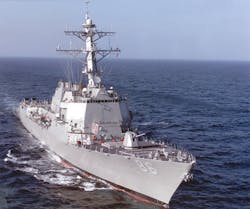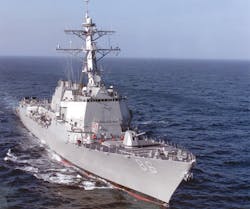Raytheon moves forward on missile-defense radar for Burke destroyer
WASHINGTON - Officials of the Naval Sea Systems Command in Washington announced a $110.2 million contract modification to the Raytheon Co. Integrated Defense Systems segment in Sudbury, Mass., for low-rate initial production long-lead material in support of the AN/SPY-6(V) Air and Missile Defense Radar (AMDR) and AMDR S-band shipboard radar (AMDR-S) systems, as well as the AMDR radar suite controller.
The Raytheon AN/SPY-6(V) AMDR will improve the late-model U.S. Navy Arleigh Burke-class (DDG 51) Aegis destroyer's ability to detect hostile aircraft and surface ships, as well as enemy ballistic missiles. The new radar will provide greater detection ranges, increased discrimination accuracy, higher reliability and sustainability, and lower costs compared to the AN/SPY-1D(V) radar onboard Burke-class destroyers.
The system is built with individual building blocks called radar modular assemblies (RMAs). Each RMA is a self-contained radar in a two-cubic-foot box; RMAs can stack together to form any size array to fit ship mission requirements. The inherent scalability of the AN/SPY-6(V) AMDR could allow for new instantiations, such as backfits on existing Burke-class destroyers and installation on aircraft carriers, amphibious warfare ships, frigates, the Littoral Combat Ship, and Zumwalt-class, land-attack destroyers without significant new radar development costs.
The Navy and its contractors are installing the AN/SPY-6(V) aboard Flight III versions of the Burke-class destroyers, none of which are completed or at sea. Navy officials have awarded contracts for three Flight III Burke destroyers to date. Two will be made by the General Dynamics Bath Iron Works segment in Bath, Me., and one will be made by Huntington Ingalls Inc. in Pascagoula, Miss.
The AN/SPY-6(V) AMDR will be 30 times more sensitive than the AN/SPY-1D(V) in the Flight III configuration, and is being designed to counter large and complex raids. The new radar will have adaptive digital beamforming and radar signal processing for dealing with high-clutter and jamming environments. The AN/SPY-6(V) also is reprogrammable to adapt to new missions or emerging threats. It uses high-powered gallium nitride (GaN) semiconductors, distributed receiver exciters, adaptive digital beamforming, and Intel processors for digital signal processing.

